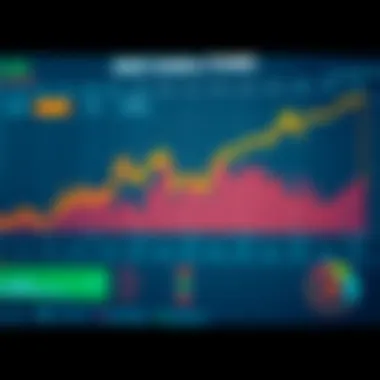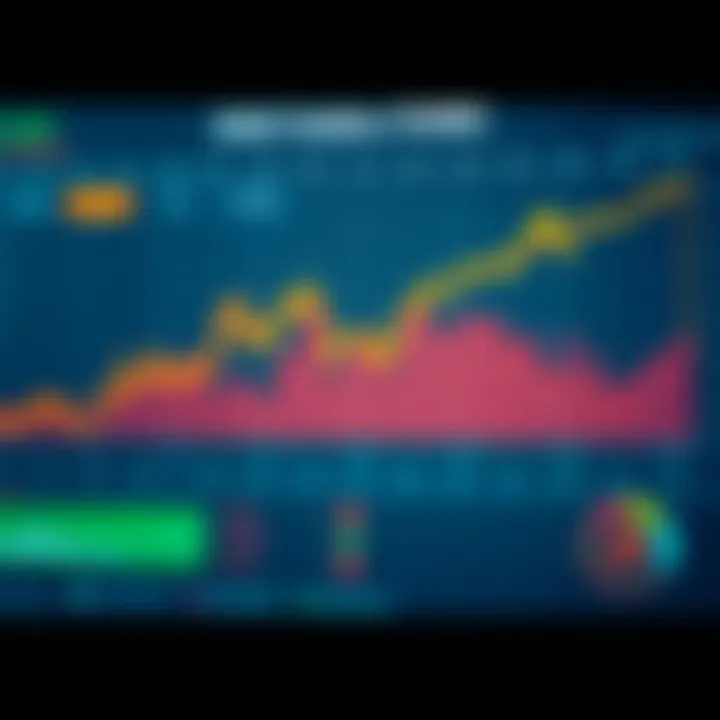DAX Index Fund: Insights for Savvy Investors


Intro
Entering the world of investing can feel like traversing a dense fog. Among the landmarks in this landscape, index funds, particularly the DAX Index Fund, stand out as reliable beacons. As an investor, being familiar with key concepts and the specific idiosyncrasies of a DAX fund can serve well in making judicious investment choices. This exploration intends to shed light on the DAX Index Fund—its structure, how it operates, and its significance within the larger framework of the German equity market.
The DAX, or Deutscher Aktienindex, reflects the performance of the 30 largest and most liquid companies traded on the Frankfurt Stock Exchange. Investing in a DAX Index Fund grants you a efficient way to gain broad exposure to the German economy without the need to meticulously pick individual stocks. By pooling resources, index funds allow investors to diversify their portfolios while mitigating risks associated with stock market volatility.
In today's article, we are going to engage in a comprehensive analysis of the DAX Index Fund, structure it in a way that's digestible, and share valuable insights from industry experts. These insights are key not just for seasoned investors, but also for those taking their first steps into investing. Whether you’re aiming to build your wealth or simply educate yourself on financial instruments, understanding the nuances of the DAX Index Fund is a pivotal aspect of your investment strategy.
With this foundation laid, let's delve into some key definitions to better equip ourselves for the upcoming discussion.
Prelude to Index Funds
When it comes to investing, understanding the tools available is essential. Index funds, now a staple in many portfolios, have gained traction over the years not just for their potential to grow wealth, but also for the unique ease and transparency they provide.
Definition and Purpose
At its core, an index fund is a mutual fund or exchange-traded fund (ETF) designed to follow a specific benchmark or index, such as the DAX 30 in Germany. The main purpose of these funds is to allow investors to gain broad market exposure without the need for frequent buying and selling, which often complicates investing. With index funds, you’re essentially investing in a snapshot of an entire market segment.
By tracking an index, such as the DAX, investors can own a slice of many companies, reducing the risk that comes with relying on the performance of any single stock.
Moreover, they typically have lower fees compared to actively managed funds, making them an attractive option for a wide array of investors, from beginners to seasoned players. In essence, index funds democratize investing, allowing nearly anyone to participate and benefit from market growth.
Evolution of Index Funds
The evolution of index funds is a tale of innovation within the financial sector. When John Bogle introduced the first index fund for individual investors back in the 1970s, it was a novel concept. He proposed a straightforward philosophy: instead of trying to pick winning stocks, investors could simply mirror the market.
Fast forward to today, and index funds have transformed dramatically. They are no longer limited to the US market. Investors can find index funds tracking various international markets, sectors, and asset classes, reflecting a more globalized investment approach. For example, the DAX 30 index fund acts as a barometer for the performance of Germany’s largest companies, offering insight into one of Europe's most important economies.
Additionally, the rise of technology and online brokerages has made acquiring these funds simpler than ever. Now, with just a few clicks, investors have access to manage and monitor their investments real-time, making it easier to adapt to market changes. This ease of access and variety of options has contributed significantly to the sustained popularity of index funds.
"In investing, what is comfortable is rarely profitable." – Robert Arnott.
Therefore, it’s crucial for investors to consider the historical context and benefits of index funds as they navigate their own investment paths. Understanding where these funds fit into the bigger picture can help make informed decisions that align with long-term financial goals.
Understanding the DAX Index
When discussing the core of the DAX Index Fund, understanding the DAX Index itself is paramount. The Deutsche Aktienindex or DAX, is Germany’s most significant stock market index, comprising the country’s 30 largest and most liquid companies. This index serves as a vital gauge of the German economy, offering insights into market performance and investor sentiment. Investing in a DAX Index Fund essentially means investing in the heartbeat of Germany’s financial life.
The DAX has evolved into more than just a collection of stocks; it embodies what investors consider when they seek exposure to the German market. There’s a treasure trove of information and potential in understanding its structure and dynamics. Investors benefit from knowing which sectors drive the index, how frequently it’s adjusted, and the economic indicators that can influence its trajectory. Here’s what you should keep in mind:
- Diverse Representation: The DAX includes companies from various sectors, such as automotive, chemicals, and technology, providing a holistic view of the economic landscape.
- Performance Indicator: Many investors look at the DAX not just to understand stock performance, but also as a predictor of economic health in Germany.
Understanding the DAX is more than academic; it’s a strategic necessity for any serious investor considering the DAX Index Fund.
Overview of the DAX Composition
The composition of the DAX is not set in stone; it reflects the companies deemed most critical to Germany’s economy. The index is calculated based on the market capitalization and liquidity of its components, which means the larger and more actively traded a company is, the greater its influence on the DAX. Noteworthy companies include:
- Volkswagen AG: A historic staple of German industry, its performance can sway the index significantly.
- SAP SE: As a beacon of technological innovation, its stock often reflects broader tech sector trends.
- Allianz SE: An essential player in the insurance and financial services sector.
One clear takeaway is that the health of the DAX mirrors not just individual companies, but also the collective economic activity in Germany. This makes it a critical area of focus for investors looking for stability and growth.
Market Influence and Performance Metrics
The market influence of the DAX is substantial, reaching far beyond the confines of Germany. It plays a pivotal role in shaping European market conditions, and its performance can have spillover effects that impact global investor sentiment. The index's metrics are essential for gauging its health. Investors often look at:
- Volatility: Indicates how much the index fluctuates, helping assess risk.
- Growth Rates: Understanding historical growth provides a backdrop against which future expectations can be managed.
- Correlation with Other Markets: The DAX often correlates with other indices, such as the S&P 500 or FTSE 100, applying context to international investment strategies.
Performance metrics can also include dividends paid by the underlying companies, which can form a respectable part of an investor’s return over time. In summary, comprehending how the DAX operates, including its components and performance metrics, arms investors with the knowledge needed to make informed decisions when pursuing a DAX Index Fund.
DAX Index Fund Varieties
Investing in DAX index funds can open many doors for both rookie investors and seasoned financial enthusiasts. Understanding the types of DAX index funds available is crucial as it directly impacts your investment choices and strategies. This section dives into the two primary varieties: physical and synthetic index funds, illuminating their distinct nuances, advantages, and what you should keep in mind.
Physical vs. Synthetic Index Funds
When it comes to DAX index funds, the distinction between physical and synthetic structures is fundamental.


Physical index funds actually own the underlying shares that constitute the DAX. This means that if you invest in a physical DAX index fund, you'll hold a piece of the companies represented in the index. Such funds tend to provide a clear, direct correlation to the DAX’s performance. It's like holding a direct line to the heartbeat of the market. Investors often appreciate this straightforward approach, as it doesn’t involve complex derivatives strategies. However, they may incur higher transaction costs tied to the buying and selling of those shares.
On the flip side, synthetic index funds use derivatives to replicate the performance of the DAX. They do not own the actual shares but rather a series of financial contracts, usually involving swaps, to achieve the same results. This approach can be less expensive in terms of fund management fees, and it often provides greater liquidity, which is a boon for active traders. Yet, it comes with its own set of risks. Relying on institutions to fulfill these contracts can create counterparty risk. Investors may need to assess their risk appetite carefully when leaning towards synthetic options.
"Investors should consider their own comfort with the complexities of these instruments before diving in."
In essence, the choice between physical and synthetic DAX index funds often hinges on an investor's strategy and risk tolerance. If you favor transparency and direct ownership, physical funds might resonate better. If cost-effectiveness and liquidity are your resolutions, synthetic funds could be your cup of tea.
Budget Considerations and Fees
Diving into the world of DAX index funds isn’t just about picking one and hoping for the best. Money management comes into play right from the get-go. Understanding budget considerations and fees is paramount to maximizing your potential return and optimizing your investment strategy.
Expense ratios are a solid starting point. These fees cover operating costs of the fund and can significantly impact your overall returns over time. For instance, a fund with a high expense ratio might erode the gains you could have earned elsewhere. Consider looking for funds with lower expense ratios, especially if you aim for long-term investment.
There are other potential fees lurking in the shadows—it’s worthwhile to consider transaction fees as well. While many brokerages have moved towards zero commission trades, if you're trading through a platform that still charges, these costs can stack up quickly with frequent trades.
Additionally, keep an eye on administration fees that funds might charge for managing your investment. Some might not be as transparent about these fees, so it’s crucial to read the fine print diligently.
Ultimately, aligning your budget considerations with the fee structure of the fund will enable you to manage your investments more effectively. Performing due diligence will save you not only money on fees but also headaches in understanding where your money is really going.
In summation, being aware of the varieties of DAX index funds, as well as the associated costs, can significantly enhance your investment journey. Keep your eyes peeled for changes that may arise in the market and remember to regularly review your investment strategy!
Advantages of Investing in DAX Index Funds
Investing in DAX Index Funds comes with a plethora of advantages tailored for both novice and seasoned investors. The elements at play range from risk mitigation and asset allocation to overall market accessibility. Grasping these benefits is paramount, particularly for those looking to enrich their investment portfolios while navigating the complexities of the financial landscape. Here’s a closer look at what makes these funds attractive to investors.
Diversification Benefits
Risk management is a cornerstone of prudent investing, which is where diversification shines. DAX Index Funds encapsulate a wide array of sectors from the heart of the German economy, ranging from automotive giants like Volkswagen to tech titans such as SAP. This broad spectrum inherently lowers risk, as downturns in specific industries can be offset by gains in others. By investing in a single fund, investors obtain stakes in multiple companies, thereby spreading out potential risks.
In addition, the DAX Index is continually updated to reflect current market conditions. This means that as companies grow or decline, the index adapts, ensuring that investors' portfolios remain relevant and dynamic. Here are specific diversification advantages of DAX Index Funds:
- Sector Exposure: By covering various sectors, investors can benefit from diverse sources of income.
- Geographic Stability: With Germany being one of Europe's strongest economies, investments in DAX Index Funds often carry less geopolitical risk when considered in comparison to funds concentrating on more volatile regions.
- Cost of Entry: DAX Index Funds provide the opportunity to invest in multiple companies at a fraction of the cost of buying individual stocks, making them accessible to a broader audience.
"Diversification doesn't guarantee against loss, but it helps to create a balanced portfolio that can weather market fluctuations."
Cost-Efficiency for Investors
When it comes to investing, every penny counts. DAX Index Funds often have lower management fees compared to actively managed funds. This is largely due to the passive management nature of index funds, where the aim is to mirror the performance of the index rather than outperform it. This cost-efficiency plays a pivotal role in enhancing investor returns.
Investors incur fewer costs over time as management fees nibble away at profits. A typical active fund might charge around 1% to 2% annually, while DAX Index Funds frequently charge 0.2% to 0.5%. Over several years, this discrepancy can lead to significant savings. Consider these notable cost factors:
- Lower Fees: Reduced management fees mean that a larger portion of the returns stays in your pocket.
- Minimal Trading Costs: Since the fund mirrors the index, there’s less buying and selling, which means fewer transaction costs.
- Performance Comparison: Historically, many passive index funds have outperformed their actively managed peers over the long run, countering any arguments that higher fees equate to better performance.
Investing in DAX Index Funds could be a wise decision for those looking to maximize their returns while minimizing costs. Considering the combination of diversification and cost-efficiency could help investors construct a more resilient portfolio.
Risk Factors Pertaining to DAX Index Funds
Understanding the risk factors related to DAX Index Funds is crucial for making informed investment decisions. The landscape of investments is rarely a straight path; it’s often riddled with bumps, turns, and sometimes unexpected detours. Investors need to recognize potential risks that could affect their holdings, especially when it comes to a fund that represents a major slice of the German equity market. Awareness of these factors not only helps investors manage their expectations but also shapes their strategies for navigating the booming yet volatile realm of index funds.
Market Volatility Considerations
Market volatility can put a damper on even the most promising investments. The DAX, being a benchmark for the German economy, can experience significant fluctuations based on both local and global market conditions. For investors in DAX Index Funds, it’s vital to realize that sharp rises and falls in the market can lead to substantial gains or losses within a short period. The volatility can stem from various sources, including but not limited to economic reports, interest rate changes, and overall market sentiment.
To put it plainly, one minute you could be on cloud nine, watching your investments soar, while the next might have you fretting over sudden downturns. Stocks within the DAX are heavily influenced by earnings reports of its constituent companies, and when those reports don’t meet expectations, it could trigger a swift sell-off. Consequently, this affects the Index Fund's value and, in turn, your returns. Therefore, it's prudent for investors to stay informed about economic indicators, keeping a watchful eye on the news and market analyses.
"Investment performance is often like a rollercoaster; it’s a thrilling ride filled with ups and downs that demand both courage and strategy."
Geopolitical Impacts on Fund Performance
Geopolitical events can throw a wrench into financial markets, and DAX Index Funds are no exception. Germany is not only the largest economy in Europe, but it also plays a pivotal role in global trade. Changes in political landscapes, trade agreements, or diplomatic relations can ripple through the market, causing uncertainties that may affect the performance of DAX Index Funds significantly.
As an investor, it’s important to have an understanding of the geopolitical climate both in Germany and abroad. For instance, trade tensions between Europe and other major economies, like the United States or China, can lead to market unease. Additionally, internal political shifts, such as elections or policy changes, can introduce volatility to the DAX.
Thus, maintaining a keen eye on both local politics and international relations is essential for DAX Index Fund investors. A seemingly distant event can have immediate impacts on market performance, making geopolitical awareness a core aspect of a successful investment strategy. In this way, investors might protect themselves from unexpected downturns that result from unforeseen global dynamics.
Stay informed, and it could save your portfolio from an unnecessary dip.
Performance Analysis of DAX Index Funds


In the world of investments, performance analysis holds paramount importance, serving as a fundamental mechanism to evaluate how well DAX Index Funds have fared over specific periods. Analyzing performance is not just about numbers; it provides investors insight into the funds' behavior in diverse economic climates. By grasping historical returns and making comparative assessments with other indexes, investors can not only gauge past effectiveness, but also form strategies that could influence future fiscal decisions. This analysis extracts lessons from the past, aiding in making informed choices moving forward.
Historical Returns Overview
When one looks at the historical returns of DAX Index Funds, a layered perspective arises. Over the years, these funds have demonstrated impressive resilience, showcasing their underlying strength in the face of market fluctuations. For instance, taking a peek at their performance during the bull market of 2016 to 2019, it's evident that the DAX saw substantial growth, driven by factors such as economic stability in Germany and favorable corporate earnings. This upward trajectory is not merely coincidental; it stems from a combination of robust market fundamentals and broader European economic trends.
Here are some pertinent points regarding historical returns:
- The DAX Index has historically yielded a compound annual growth rate (CAGR) of approximately 9% over the last decade.
- Significant upward shifts were noted post-economic downturns, indicating a bounce-back capacity.
- Lower points in the market, like in 2020 during the pandemic, tested these funds but also showcased recovery vigor.
Investors who have consistently held DAX Index Funds tend to find that while short-term volatility might tempt quick sales, staying the course can lead to noteworthy long-term gains.
Comparative Analysis with Other Index Funds
When investors seriously consider the DAX Index Fund, it is crucial to situate it within the larger context of other index funds available. Comparative analysis not only highlights the unique positioning of the DAX, but also reveals its advantages and potential drawbacks against competitors like the S&P 500 or the FTSE 100.
For clarity, here are several factors often compared:
- Performance: While the DAX exhibits a consistent growth pattern, funds like the S&P may outshine in tech-heavy years, thanks to their exposures to big tech companies.
- Fees: DAX Index Funds tend to offer lower expense ratios compared to some actively managed funds, but competitive analysis must check whether they match similar index offerings.
- Diversification: DAX is concentrated in German stocks, while broader index funds provide exposure to a wider array of sectors beyond national boundaries. However, that same concentration can serve as a strength for investors wanting to capitalize on Germany's specific economic dynamics.
"Investing is not about timing the market, but about time in the market."
Investors who perform due diligence and compare DAX Index Funds with alternative choices can better ascertain their fit within personal or institutional portfolios. Thus, evaluating returns and juxtaposing with other index offerings ultimately assists in crafting robust investment strategies that reflect both risk tolerance and financial goals.
For further information, check out other useful resources like Investopedia or the Börse Frankfurt for up-to-date analysis and reports.
Investment Strategies Utilizing DAX Index Funds
Investing in DAX Index Funds is not just about buying shares; it’s about embracing a comprehensive approach that syncs with one’s financial goals and market insights. As an investor, grasping the various investment strategies can significantly influence both returns and risk management. In this section, we’ll explore how to effectively use these funds in your portfolio while discussing the benefits and factors to consider.
Long-Term Investment Perspectives
When it comes to investing, patience is often more than just a virtue; it’s a strategy. Long-term investment perspectives around DAX Index Funds focus on the potential for capital appreciation over time. The German stock market, which the DAX represents, has historically shown resilience and growth, making it an appealing choice for those willing to stay the course.
Investors who opt for a long-term strategy often still their impulses during market downturns. This approach is based on the understanding that market fluctuations can lead to panic selling, which in the long run may sacrifice profits. Instead, by holding onto DAX Index Funds through thick and thin, investors can benefit from compounding returns.
Additionally, this strategy allows for dollar-cost averaging, a method where an investor buys into the fund at regular intervals, regardless of the share price. Over time, this can lower the average cost per share, especially during bear markets. The goal is simple: secure a slice of the market's growth without the stress of constantly trying to time your investments.
Tactical Asset Allocation Techniques
Tactical asset allocation is a more dynamic investment approach compared to the traditional buy-and-hold strategy. This method allows investors to adjust their exposure to DAX Index Funds based on perceived market conditions and economic indicators. Such flexibility presents a distinct advantage, especially in a market as fluid as equities.
By monitoring economic signals—like interest rates, inflation rates, and even international market performance—investors can make timely decisions to increase or decrease their investment in DAX Index Funds. Here are some facets to consider with tactical asset allocation:
- Market Analysis: Keeping an eye on macroeconomic trends, and geopolitical developments can help inform decisions. For instance, if Germany’s economic indicators suggest growth, ramping up investment might pay off.
- Rebalancing Portfolio: Periodically, it’s wise to assess the overall portfolio’s performance and risk. This can mean tilting investment more towards DAX Index Funds if they are underperforming or reducing exposure in favor of other assets if the DAX is riding high.
- Windfall Adjustments: If a significant event occurs—be it political, economic or social—that could impact the market, adjusting positions swiftly in DAX Index Funds could create advantageous opportunities.
Remember, the best investment strategy is one that reflects your goals, risk tolerance, and market understanding.
For a deeper understanding of investment strategies, you can explore resources like Investopedia or look into ongoing discussions on platforms like Reddit.
Let’s keep expanding your investment knowledge and set the stage for smarter financial decisions.
Tax Implications for DAX Index Fund Investors
When considering investment in DAX index funds, understanding the tax implications is crucial. Taxes can significantly affect your overall returns. For investors, comprehending how taxes impact gains and income from these funds facilitates smarter decision-making. The DAX index, representing major German companies, brings unique considerations related to capital gains, dividends, and different tax scenarios.
Understanding Capital Gains Tax
Capital gains tax arises when an asset, like a DAX index fund, is sold for more than its purchase price. In Germany, the rates vary depending on whether the gains are short-term or long-term. Selling after one year generally qualifies for more favorable tax treatment, while short-term gains could see you paying more.
For investors, it's important to maintain records of purchase prices and sale dates. This documentation will support your case if you ever need to establish the length of time you held the investment. Some investors, however, may be unaware of the "Sparfreibetrag," which allows for some tax-free gains each year. Consequently, individuals should ensure they don’t overlook this benefit, as it can dutifully spare them from tax liabilities on modest gains.
"A sound strategy against taxes often lies within the investment horizon; the longer you hold, the better off you may be."
Tax-Advantaged Accounts and Index Funds
Utilizing tax-advantaged accounts can magnify the attractiveness of investing in DAX index funds. In Germany, options like "Riester" and "Rürup" pensions allow individuals to invest while receiving tax benefits. Deferring taxes until withdrawal can lead to significant tax savings over time.


On the other hand, many investors may opt to leverage accounts that enforce different tax treatment for qualified distributions. Thus, understanding the account types you’re using is essential when formulating an investment strategy. Here’s a brief rundown of account types:
- Riester Pension: Tax advantages during contributions and benefits upon retirement.
- Rürup Pension: Tailored for self-employed individuals, providing similar tax breaks.
- Regular Investment Accounts: Subject to capital gains taxes, but may allow for loss offsets.
For further reading on tax rules for investors, check out the official German tax website or visit Wikipedia on capital gains tax.
Ultimately, solid tax knowledge interlocks with wise investment choices—for DAX investors, being tax-savvy can deepen the experience and wealth potential.
Choosing the Right DAX Index Fund
Selecting a suitable DAX Index Fund is like finding a needle in a haystack for many investors. The right fund can provide not only a substantial return but also a hedge against market uncertainties. An informed choice will hinge on several critical considerations.
Parameter-Based Evaluation Criteria
When evaluating DAX Index Funds, investors need to keep an eye on several parameters that can significantly influence their investment experience. Here are a few crucial elements to consider:
- Expense Ratio: This is a key indicator of how much you’ll pay annually to maintain your investment in the fund. Lower expense ratios can save you a pretty penny over time and boost your net returns.
- Tracking Error: This metric lets you know how well a fund copies the performance of the DAX index itself. A smaller tracking error indicates a more faithful replication of the benchmark.
- Minimum Investment Requirement: Different funds come with varied initial investment thresholds. Knowing this ahead of time can help avoid surprises.
- Fund Size: Larger funds generally indicate popularity and may have better liquidity, making it easier to buy or sell shares without affecting the price.
"Understanding these parameters not only informs your investment decision but adds layers to your investment strategy."
- Dividend Yield: This can be particularly attractive to those looking for income in addition to capital gains. Checking how a fund pays dividends can be quite instructive.
- Fund Manager Experience: The expertise of those managing the fund can dramatically affect its success. A seasoned manager is often more adept at navigating market volatility.
By considering each of these criteria, investors can make a more nuanced decision that aligns with their financial goals.
Product Offerings Overview from Key Providers
Now let’s take a closer look at some predominant players in the DAX Index Fund space. These providers offer a variety of funds tailored to different investor needs:
- iShares DAX UCITS ETF: This fund is tailored for those seeking a straightforward option. It replicates the DAX index with a low expense ratio and solid performance metrics. Ideal for long-term investors.
- Xtrackers DAX UCITS ETF: Known for its transparency and innovative strategies, this fund appeals to those looking for various reward mechanisms and tax efficiency.
- Comstage: Offers unique tracking features that help investors align more closely with their financial aspirations, catering to both cautious and aggressive investors.
Each of these providers showcases different strengths in their fund offerings. It’s wise to explore each option carefully to find the one that aligns best with your specific investment strategy.
In summary, choosing the right DAX Index Fund isn’t just about picking any fund; it’s about picking the right one for you. By weighing the parameters and understanding the options available, investors can set themselves up for greater success in their financial journey.
Future Outlook for DAX Index Funds
The future of DAX Index Funds is a topic that deserves attention, particularly as investments pivot towards more innovative and adaptable financial solutions. As these index funds become more entrenched in the investment landscape, understanding their trajectory is crucial for both novice and experienced investors. The DAX, or Deutscher Aktienindex, continues to be a bellwether for Germany's economic health, and this directly influences the investment strategies associated with its index funds.
Market Trends and Predictions
In the realm of index investing, trends often shape market dynamics. Currently, there is a noticeable shift towards sustainable investing, which has garnered interest among investors who are mindful of environmental, social, and governance (ESG) factors. With major companies in the DAX committing to sustainability, DAX Index Funds could see an increased demand as investors look for ways to align their portfolios with their values.
Furthermore, the adoption of technology in finance continues to grow. Robo-advisors and algorithm-driven strategies are becoming commonplace, making it easier for investors to access diversified portfolios, including DAX Index Funds. This technological evolution may lead to an uptick in participation from both retail and institutional investors, bolstering fund performance.
Equity markets in Europe also show resiliency, despite past challenges such as geopolitical tensions and fluctuating economic conditions. As Europe's economy stabilizes post-crisis, DAX Index Funds are poised to benefit from an influx of investment, potentially leading to promising returns.
However, it's essential to remain vigilant about interest rates—central bank policies can alter market conditions. Should rates rise significantly, it might dampen stock market enthusiasm, affecting performance metrics of equity funds, including those that track the DAX.
Innovative Investment Vehicles in Development
The landscape of DAX Index Funds is evolving with innovative vehicles designed to enhance investment experiences. Some fund managers are pioneering platforms that allow for more precise exposure to specific sectors within the DAX, like health care or technology. These niche funds could enable investors to target their investments towards high-growth sectors without sacrificing the broad diversification that index funds provide.
Additionally, products like exchange-traded funds (ETFs) continue to gain popularity among investors for their liquidity and lower fees compared to traditional mutual funds. These ETFs can offer a dynamic means of gaining exposure to the DAX, especially as new offerings emerge that focus on unique themes or investment ideas.
The rise of fractional investing is also on the horizon, allowing investors to buy smaller shares of index funds without needing substantial capital upfront. This option democratizes access to investing in the DAX, making it feasible for a wider audience.
As the regulatory landscape shifts, there may also be opportunities for more creative wrappers around index strategies, enabling tax efficiency or risk mitigation.
In summary, the future outlook for DAX Index Funds is embedded in a flux of trends and innovations. Observing these factors closely can provide investors with critical insights into how to position their investments wisely in an ever-evolving financial environment.
Culmination
In closing, the exploration of DAX Index Funds sheds light on a pivotal investment vehicle for both new and experienced investors. This discussion counts more than just numbers; it encapsulates the broader understanding of how DAX funds work and why they matter against the backdrop of the German equity market. Investing in a broad portfolio of stocks can reduce risk and expose investors to potential growth, making DAX funds attractive for a variety of investment strategies.
Summarizing Key Insights
- Diversity in Exposure: One of the primary takeaways from this article is the diversification benefit of DAX Index Funds. By investing in a fund that mirrors the DAX index, investors can gain exposure to the leading German companies without putting all eggs in one basket.
- Cost-Effectiveness: DAX Index Funds often come with lower fees compared to managed funds. This cost-efficiency is a considerable advantage for long-term investors aiming to build wealth incrementally.
- Market Performance: Understanding the historical performance of the DAX can help investors gauge future potential. Various metrics have shown that, despite market fluctuations, the DAX has shown resilience over the long run.
- Risk and Reward: It's crucial to weigh the risks associated with market volatility and geopolitical influences. Investors should remain informed and align their investments with their risk tolerance.
- Future Prospects: Keeping an eye on market trends and evolving investment products can offer insights into future opportunities in the DAX space, potentially leading to innovative strategies.
Moving Forward with DAX Investments
For investors contemplating DAX Index Funds, it's essential to adopt a strategic mindset. Here are some considerations and actions for the journey ahead:
- Evaluate Your Financial Goals: Understanding your investment objectives is key before diving into DAX Funds. Are you seeking growth, income, or both?
- Stay Informed: Regularly monitoring developments in the German economy and global finance will provide context for the performance of DAX. Resources like Wikipedia and financial news from credible sites can keep you up-to-date.
- Consider the Tax Implications: DAX Index Funds, while beneficial, may also come with tax reviews pertaining to capital gains. Knowing how to navigate these aspects can safeguard your investments.
- Experiment with Different Funds: Don’t hesitate to explore varying options among DAX products. Each fund can behave differently based on fees, management, and underlying assets.
- Consult Financial Advisors: If the landscape feels overwhelming, tapping into a financial advisor’s expertise can elucidate details specific to your situation.
Ultimately, investing in DAX Index Funds should be seen as part of a broader portfolio strategy, one that aligns closely with personal financial aspirations. Taking action today could be the steppingstone for robust financial health tomorrow.







